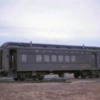As a model RR I have read about prototype passenger cars and they always refer to them by their length. 60 feet, 70 feet, 80 feet are common lengths.
I understand that these lengths refer to the distance between the vestibules, but do include the vestibules. So 70 ft coach for example might be 76-78 feet long when you add the vestibules. But a 70 baggage car would be only 70 feet long.
Now my question is, what is the reference to 21 inch cars? Or to 15 inch cars or 20 inch cars in the model railroad? What does this measurement refer to relative to the real car?
What prototypes do they represent?
Just some food for thought and disussion.






